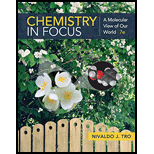
Interpretation:
The working of an automobile battery is to be explained and the reactions occurring at cathode and anode are to be discussed.
Concept introduction:
An automobile battery is the type of the battery that converts chemical energy into electrical energy.
Oxidation is the addition of an electronegative element or the removal of an electropositive element in a
Reduction is the addition of an electropositive element or the removal of an electronegative element in a chemical reaction.
The chemical reaction in which oxidation process and reduction process take place simultaneously, is called a
Answer to Problem 13E
Solution:
The automobile battery is formed when lead oxide and sponge lead are immersed in dilute sulphuric acid.
The sulphuric acid completely dissociates into
The positively charged hydrogen moves towards the electrode that is connected to the negative terminal. The negatively charged sulfate ion moves towards the electrode that is connected to the positive terminal.
The two half reactions are as:
Explanation of Solution
The automobile battery is a lead-acid storage battery. The lead-acid storage battery is the type of the battery that converts chemical energy into electrical energy. The electrical energy is converted into chemical energy with help of an external source and is called charging of the automobile battery. The chemical energy is converted into electrical energy with the help an external load and is called discharging of the automobile battery. The materials used in the automobile battery are lead oxide, sponge lead and dilute sulphuric acid.
Sulphuric acid completely dissociates into
Adding two half reaction gives the overall cell reaction as follows:
The reaction occurring at the cathode is as follows:
The reaction occurring at the anode is as follows:
Want to see more full solutions like this?
Chapter 14 Solutions
Chemistry In Focus
- . In which direction do electrons flow in a galvanic cell, from anode to cathode or vice versa?arrow_forwardThe following diagram shows a molecular view of the electrochemical cell diagrammed in Figure 14.2. Draw a molecular view showing the changes that occur after the cell has produced electrical current for some extended period of time.arrow_forward

 Chemistry for Engineering StudentsChemistryISBN:9781337398909Author:Lawrence S. Brown, Tom HolmePublisher:Cengage LearningChemistry: Matter and ChangeChemistryISBN:9780078746376Author:Dinah Zike, Laurel Dingrando, Nicholas Hainen, Cheryl WistromPublisher:Glencoe/McGraw-Hill School Pub Co
Chemistry for Engineering StudentsChemistryISBN:9781337398909Author:Lawrence S. Brown, Tom HolmePublisher:Cengage LearningChemistry: Matter and ChangeChemistryISBN:9780078746376Author:Dinah Zike, Laurel Dingrando, Nicholas Hainen, Cheryl WistromPublisher:Glencoe/McGraw-Hill School Pub Co Chemistry: The Molecular ScienceChemistryISBN:9781285199047Author:John W. Moore, Conrad L. StanitskiPublisher:Cengage Learning
Chemistry: The Molecular ScienceChemistryISBN:9781285199047Author:John W. Moore, Conrad L. StanitskiPublisher:Cengage Learning World of Chemistry, 3rd editionChemistryISBN:9781133109655Author:Steven S. Zumdahl, Susan L. Zumdahl, Donald J. DeCostePublisher:Brooks / Cole / Cengage Learning
World of Chemistry, 3rd editionChemistryISBN:9781133109655Author:Steven S. Zumdahl, Susan L. Zumdahl, Donald J. DeCostePublisher:Brooks / Cole / Cengage Learning Introductory Chemistry: A FoundationChemistryISBN:9781285199030Author:Steven S. Zumdahl, Donald J. DeCostePublisher:Cengage Learning
Introductory Chemistry: A FoundationChemistryISBN:9781285199030Author:Steven S. Zumdahl, Donald J. DeCostePublisher:Cengage Learning





